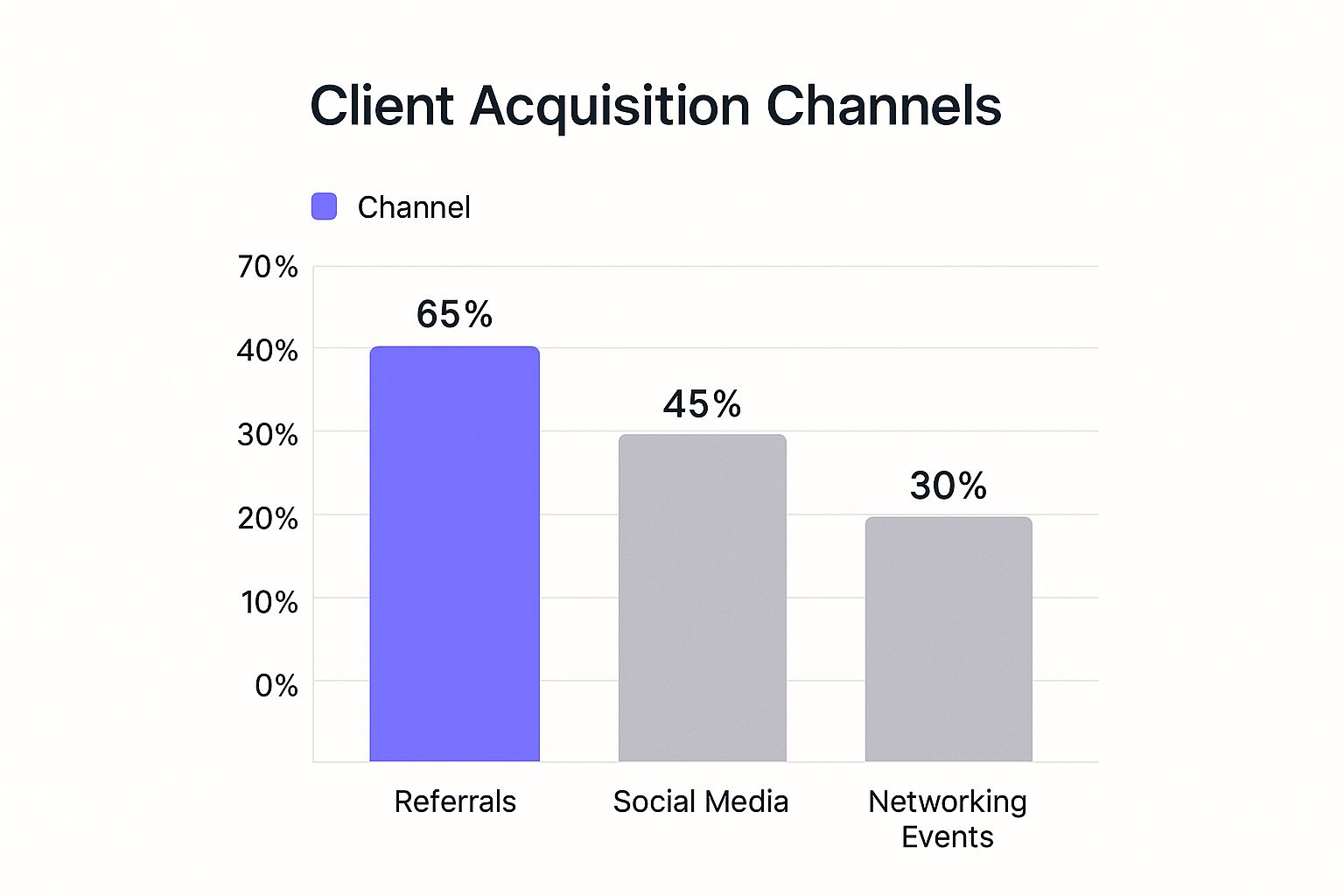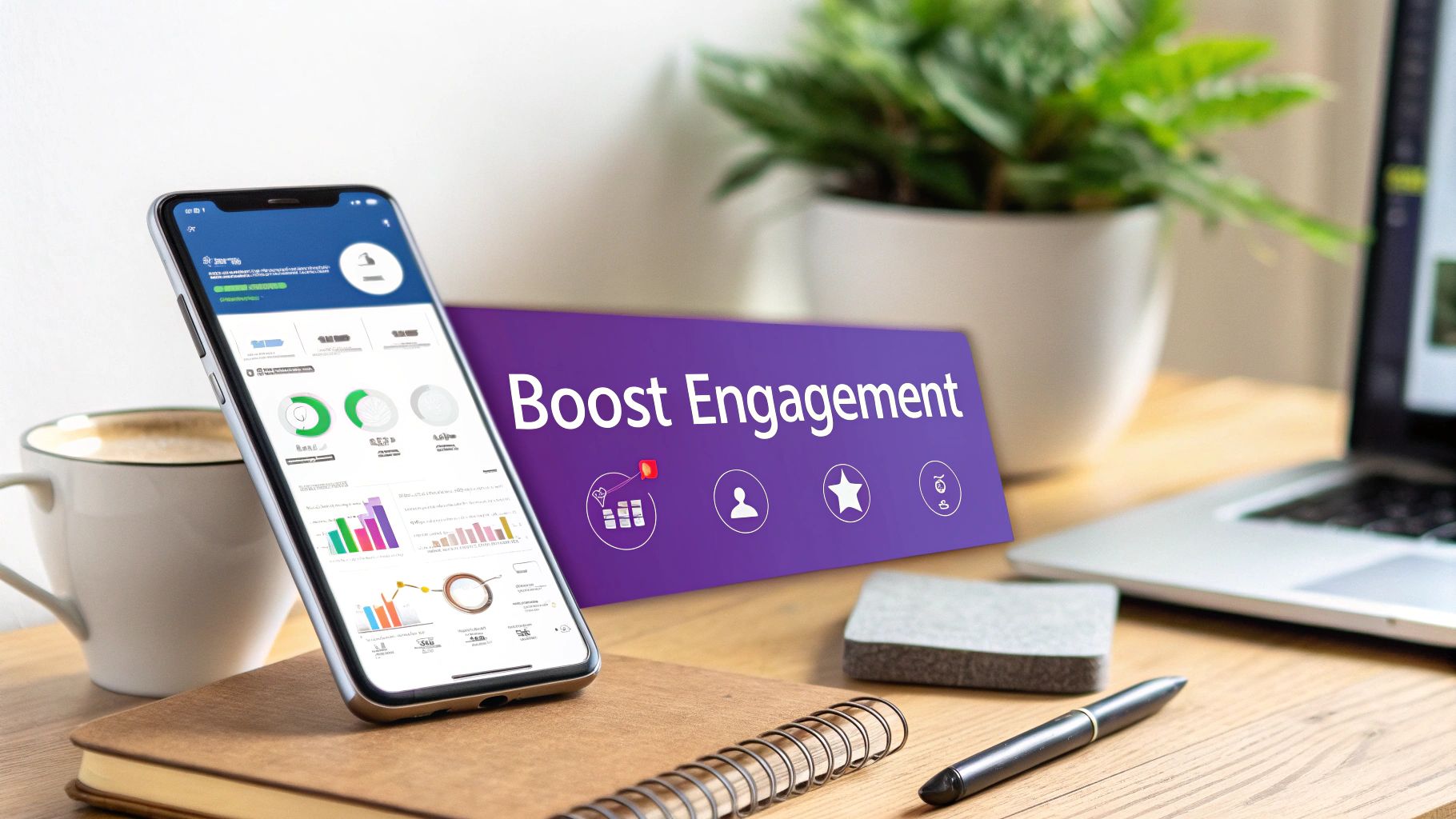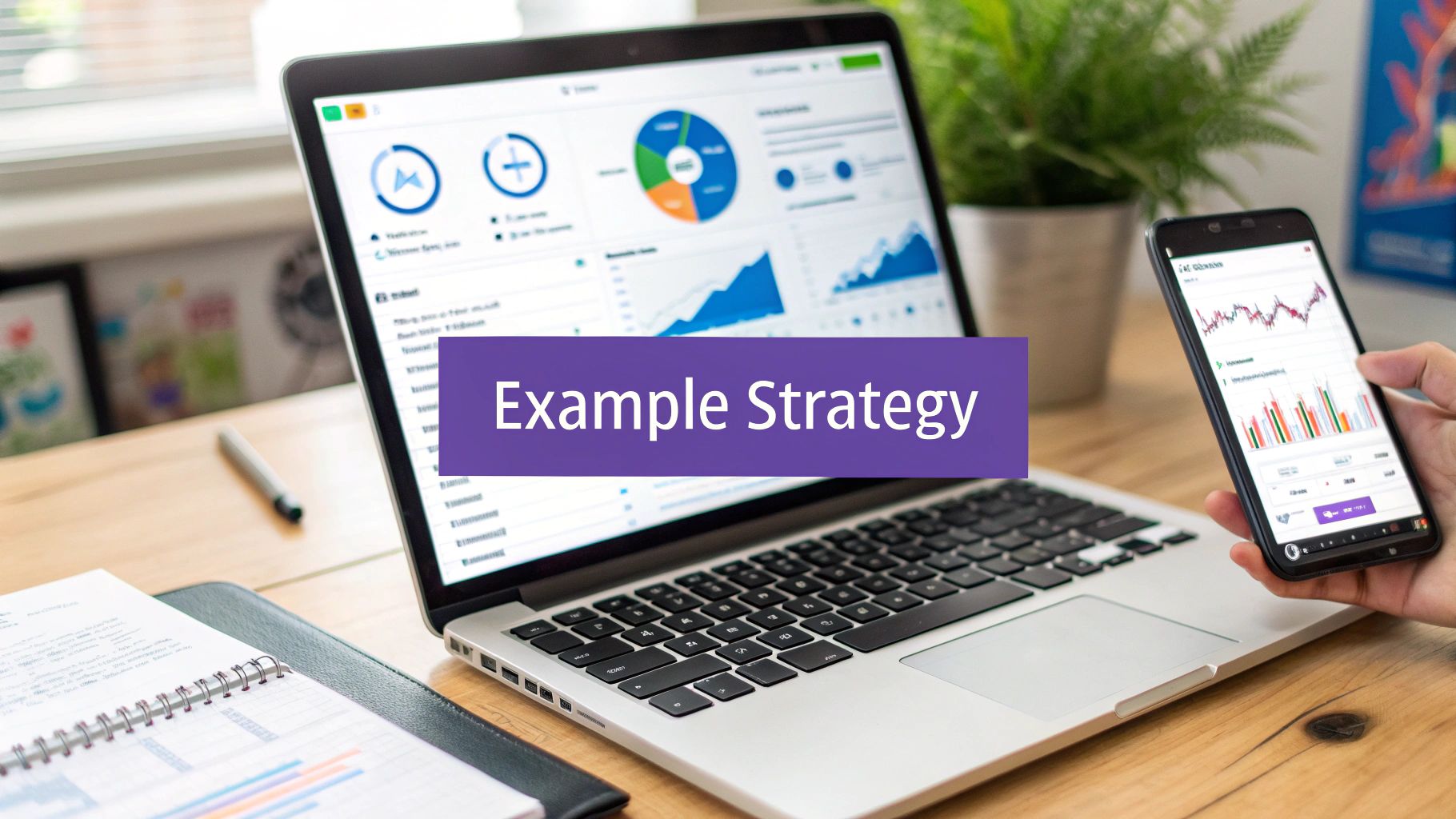How to Attract Clients Who Value Your Expertise

Attracting the right clients isn't about chasing down every possible lead. It’s about making a strategic shift—stop chasing, and start building a magnetic presence that draws your ideal customer directly to you. This means moving away from generic outreach and creating an online ecosystem where your expertise is so obvious that you become the only logical choice for high-value projects.
Why Attracting the Right Clients Feels Impossible
If finding great clients feels like an uphill battle, you’re not imagining things. The digital world is incredibly crowded, making it a real challenge to stand out from the noise. Your potential clients are bombarded with generic pitches and empty promises every single day, which means they've become more skeptical than ever. The old playbook of just broadcasting your services just doesn't cut it anymore.
This isn't just a feeling; it's a measurable trend. Research consistently shows that getting new customers is a massive hurdle for businesses. One survey found that 61% of marketers named generating website traffic and leads as their number one challenge. Another report revealed that 73% of Chief Marketing Officers agree that improving customer acquisition is critical to staying competitive. If you want to dive deeper, you can explore more data on customer acquisition challenges to see the full picture.
Moving Beyond Volume to Value
The root of the problem is often a focus on quantity over quality. Chasing any and every lead that crosses your path is exhausting, and it rarely leads to the fulfilling, profitable projects you actually want. The smart move is to pivot your entire approach.
The most effective way to attract clients is to stop chasing them. Instead, build a system that makes you so visible and credible that they come to you, already convinced of your value.
This is all about building a foundation of authority and trust. It's about turning your online presence from a passive resume into an active client-attraction engine. When you get this right, you stop being just another service provider and become the go-to expert in your field.
Take a look at this chart. It shows the most common ways professionals are finding clients right now, with referrals leading the pack by a wide margin.

The data makes it crystal clear: trust-based channels like referrals are incredibly powerful. This reinforces the need to build a rock-solid reputation. Your goal should be to replicate that same level of referral-like trust through your online activities, creating a system that consistently brings high-quality prospects to your door.
This shift from a volume-based approach to a value-driven one is fundamental to modern client attraction. The old way was about casting a wide net, while the new way is about becoming a lighthouse.
The Modern Client Attraction Funnel
| Stage | Traditional Focus (Volume) | Modern Focus (Value) |
|---|---|---|
| Awareness | Broadcasting ads to a broad audience. | Sharing targeted, expert content. |
| Interest | Pushing generic sales pitches. | Demonstrating expertise and building trust. |
| Consideration | Offering one-size-fits-all solutions. | Providing tailored insights and case studies. |
| Conversion | Closing a deal with anyone. | Attracting clients who are a perfect fit. |
Ultimately, this modern funnel isn't just about getting a client; it's about getting the right client—one who sees your value, respects your expertise, and is excited to work with you.
Build an Online Presence That Attacts Your Ideal Client

Think of your online profiles as your most powerful client filter. A generic headline and a bio that just lists your services? That’s a massive missed opportunity. If you want to attract high-value clients, your digital footprint on platforms like LinkedIn or your personal site needs to act like a magnet, pulling in the right people and gently repelling those who aren't a good fit.
The real key is a mindset shift: stop talking about "what I do" and start focusing on "what I solve." High-value clients aren't just buying a service; they're buying a solution to a painful, expensive problem. Your online presence has to nail this idea from the very first glance.
Craft a Problem-Centric Headline
Your headline is the most valuable real estate on your entire profile. It has one job: stop your ideal client mid-scroll and make them think, "This person gets it." Ditch the job title and frame your headline around the outcome you deliver.
Let’s look at two approaches for a freelance web developer:
- Generic Headline: "Freelance Web Developer | WordPress & Shopify Expert"
- Client-Centric Headline: "I build e-commerce sites that turn visitors into repeat customers for DTC brands."
See the difference? The first headline is just a label. The second is an active promise that speaks directly to a business owner’s biggest desire—more sales. It shows you know how to attract clients by focusing on their success, not just your own skills.
The most effective profiles don't just list what you do; they articulate the value you create for the specific people you want to serve. This simple change transforms your profile from a resume into a lead-generation tool.
This principle should echo through every part of your profile. Every single word should be working to qualify or disqualify potential leads, which will save you countless hours on discovery calls with prospects who were never going to be a good fit anyway.
Showcase Results, Not Just Services
Once your headline grabs their attention, your bio and experience sections have to deliver the proof. The most common mistake I see is a long, bulleted list of services. This forces the client to do the mental heavy lifting to figure out how your skills apply to their problem. Don't make them work so hard. Show them.
Instead, weave your services into mini-case studies. For every major project or role, don't just say what you did. Use this simple framework:
- Problem: State the client's challenge in a nutshell.
- Action: Describe the specific steps you took to solve it.
- Result: Quantify the outcome with real, hard numbers.
For example, instead of just saying "Managed social media," try this:
"A SaaS startup was struggling with low trial sign-ups (Problem). I developed and executed a targeted content strategy on LinkedIn, sharing industry insights and customer success stories (Action). This resulted in a 45% increase in qualified leads and a 20% jump in trial conversions within three months (Result)."
This method builds instant credibility. It shows potential clients that you're not just another service provider, but a strategic partner laser-focused on delivering a return on their investment. To really build a solid framework for this, you might consider using a social media marketing plan template to structure all your efforts. It ensures your online presence isn't just active, but strategically aligned with your actual business goals.
Sure, here is the rewritten section, crafted to sound like it was written by an experienced human expert, following all the provided style and formatting guidelines.
Create Content That Pre-Sells Your Expertise
Having an optimized profile gets your foot in the door, but it's your content that truly seals the deal. To draw in clients who see the value in what you do and are ready to pay for it, you need to create content that acts as your 24/7 salesperson. It should build trust and show off your expertise long before you ever hop on a call.
The secret isn’t to guess what they want to read. It's about becoming a digital detective and systematically uncovering their biggest problems—then answering them for everyone to see.
This means you need to go where your ideal clients are. Spend some time digging through industry-specific subreddits, browsing Quora questions in your field, and joining relevant Facebook groups or Slack communities. Your mission is to spot the recurring questions, frustrations, and pain points that scream "I have a business problem I need to solve."
Turn Pain Points Into Authority-Building Content
Once you have a list of those problems, you've basically got your content roadmap. The trick now is to stop creating content for your peers and start creating it for your future clients. It’s a classic mistake: we create content to impress other experts in our field, but it flies right over a potential buyer's head.
Think about a brand designer. They might be tempted to write a tutorial on some advanced Illustrator technique. It’s great for other designers, but it does absolutely nothing to attract a business owner who desperately needs a new logo. A much smarter move is to address the client's actual problem.
A potential client isn’t thinking, "I need someone who is a master of the pen tool." They're thinking, "My current branding looks amateurish and isn't attracting the right customers." Your content has to bridge that gap.
So, instead of that technical tutorial, the designer could write a blog post titled, "5 Common Branding Mistakes That Are Costing Your Business Sales." This title hits on a real business outcome, framing the designer as a strategic partner, not just a technician. Content like this pre-sells your value by proving you get their business challenges.
Choose Formats That Build Trust
What you create is just as important as why you create it. Different content formats serve different purposes on your journey to landing more clients.
Here are a few formats that really work:
- Behind-the-Scenes Breakdowns: Walk people through your process on a real project. Talk about the initial challenge, the steps you took to solve it, and the final results. This demystifies what you do and builds a ton of confidence.
- "Why You Need..." Posts: Connect your service directly to a painful business problem. Something like, "Why Investing in a Professional Website Is No Longer Optional." This reframes your service as a must-have investment, not a nice-to-have expense.
- Client Q&As: Get on a call with a past client and interview them about their experience working with you. This is powerful social proof that lets a happy customer do the selling for you.
Let's face it, the business world is digital now. These channels are only becoming more dominant in how clients find help. In fact, digital platforms are expected to capture nearly 61% of all global advertising spend. This just proves that being visible and credible online isn't optional anymore; it's the main way you connect with your audience. You can discover more insights about client engagement trends on G2.com to see the full picture.
By consistently putting out helpful, client-first content, you tap into this reality. You're building a library of assets that attract, educate, and convert your ideal clients around the clock.
Engage Authentically Where High-Value Clients Gather

So you've polished your profile and have some brilliant content ready to go. That’s great, but it won't mean much if the right people never see it. Now it's time to shift gears from just creating things to proactively engaging where it counts. You have to go where your ideal clients already are and become a familiar voice in their conversations.
This isn't about blasting your links everywhere or dropping generic "great post!" comments. It’s about strategically showing up in the online communities and discussions where your target clients spend their time. By joining the conversation, you build recognition and showcase your expertise in a way that feels genuinely helpful, not salesy.
Think of it like walking into an industry conference. You wouldn't just march in, shout about your services, and walk out. You'd listen, ask smart questions, and offer valuable insights when you could. The goal online is exactly the same: build a reputation as the go-to expert people trust.
Find Your Digital Watering Holes
First things first, you need to figure out where your ideal clients hang out online. This takes a bit of detective work, but believe me, the payoff is huge. You’re not just looking for any community; you're looking for active spaces where people are discussing real business challenges.
Here are a few common spots to start your search:
- Niche Subreddits: Look for subreddits related to your client's industry, not just your own. If you're a B2B software consultant, you should be hanging out in places like
r/smallbusinessorr/SaaS, not justr/consulting. - LinkedIn Groups: Find groups centered around specific professional roles or challenges. A project management expert, for instance, might join groups for "Product Managers" or "Startup Operations."
- Industry-Specific Forums: Many professions have dedicated online forums that are absolute goldmines. You'll find high-quality discussions and learn the exact language your clients use to describe their pain points.
Once you’ve found a few promising spots, just lurk for a bit. Get a feel for the culture, see who the key influencers are, and pay attention to the questions that pop up over and over. This kind of research is how you learn to speak your client's language fluently.
Engage With a Value-First Mindset
Okay, you've found the right places. Now it's time to jump in. The key here is to always lead with value. Your goal isn't to land a sale in the comments section; it's to be so incredibly helpful that people get curious and decide to check you out on their own.
When you consistently provide value without asking for anything in return, you build trust at scale. This trust is the foundation that turns a cold audience into warm inbound inquiries.
Here’s a simple, practical framework for how to engage:
- Answer Questions Thoughtfully: Find a question you can answer with real expertise. Don't just give a one-liner; provide a clear, detailed response that actually solves their immediate problem.
- Share Contextual Resources: If you have a blog post or video that perfectly answers a question, share it. But frame it helpfully, not as a promotion. For example: "I actually wrote a detailed guide on this exact topic. It might help you with [specific point]. You can find it here."
- Validate Others' Contributions: Agreeing with and adding to someone else's great advice is a fantastic way to participate. It shows you're a team player and not just there to toot your own horn.
This approach builds a reputation for generosity and expertise. People will start to recognize your name and associate it with helpful, no-nonsense advice. This is how you attract clients without ever feeling like you're "selling." The conversation will naturally shift from the public forum to private DMs, where you can gracefully transition to a more formal consultation.
Transition from Conversation to Consultation Gracefully

This is the moment all your hard work leads up to. After putting in the time to build trust and provide real value, you’ll start to see conversations shift from public threads into your private messages. Knowing how to handle this pivot is what separates a friendly chat from a signed client—all without coming across as salesy.
The real art is making the move to a consultation feel like the most natural next step for them. It’s less about pushing a sale and more about listening for the subtle cues hidden in their messages. These aren't always obvious "I want to hire you" statements. More often, they're questions about complexity, scope, or specific roadblocks that signal they need more than just a quick DM reply.
Recognizing Buying Signals
When someone starts asking deeper, more detailed questions, their interest has officially moved beyond casual curiosity. They're now actively looking for a solution, and that's your cue to gently guide them toward a more focused conversation.
Keep an ear out for questions that sound something like this:
- "That's exactly the problem we're facing. How would you handle...?"
- "I've tried a few things, but I'm still stuck on [specific issue]."
- "This is more complex than I thought. What does a typical project like this involve?"
These are gold. They're direct invitations to step in and offer more substantial help. But firing back a wall of text in their DMs can be overwhelming. This is the perfect opening to suggest a quick, no-pressure call to give them some real clarity.
The No-Pressure Invitation
Your offer for a call should always be framed as a benefit to them. You’re not trying to sell; you're offering to help. This simple shift keeps the dynamic collaborative and makes the other person feel heard and supported, not cornered.
The most effective way to suggest a call is to connect it directly to their stated problem. Position the chat as a quick, valuable way for them to get unstuck, making it an easy 'yes.'
For example, you could say: "It sounds like you're navigating a tricky situation with [specific problem]. I've helped other founders with similar challenges. Would a brief 15-minute chat be helpful to see if I can offer some clarity?"
This approach works because it’s specific, low-commitment, and all about their needs. To make this transition even smoother, you can use tools for document workflow automation to handle the backend logistics. It ensures that from the very first formal interaction, you look professional and have your process dialed in.
Frequently Asked Questions About Attracting Clients
Even when you have a clear game plan, putting it all into practice can stir up new questions. Let's be honest, the road to a steady stream of clients has a few common bumps. Knowing how to handle them is what separates those who succeed from those who give up too soon.
This is where we tackle the questions that come up time and time again. Think of this as your field guide for troubleshooting your client attraction strategy, filled with straightforward advice to keep you moving forward.
How Much Time Does This Really Take?
This is probably the number one question I get, and the honest answer is: it depends. It hinges on where you're starting from and how consistent you can be. If you’re building your presence from the ground up, you should probably budget 5-7 hours a week for the first couple of months.
That time will be a mix of things—polishing your online profiles, creating one really solid piece of content, and actually talking to people in relevant online communities.
The great part? This isn't just time spent; it's an investment. The authority you build and the content you publish will keep working for you around the clock, long after you've put in the initial effort. It’s less of a daily chore and more like building a valuable, lead-generating asset for your business.
What If I Am Not Seeing Results Immediately?
It’s completely normal to feel a bit antsy if your inbox isn't overflowing with warm leads in the first few weeks. It's so easy to get discouraged. But before you pivot or abandon your strategy, give it at least 90 days to really get going. Building trust and becoming a familiar face in your niche simply doesn't happen overnight.
Now, if you hit that three-month mark and it's still crickets, it’s not time to scrap the whole plan. It's time to play detective. Ask yourself a few tough questions:
- Is my targeting too broad? A message aimed at everyone resonates with no one. Go back to your ideal client profile. Is your content speaking directly to their biggest headaches?
- Am I genuinely providing value? Look at your recent posts and comments. Are you truly helping, or does it feel a little too much like a sales pitch? Value first, always.
- Am I hanging out in the right places? You might be in a group full of your peers instead of your potential clients. It happens! Take a hard look at where you're spending your engagement time.
A lack of immediate results usually points to a problem with targeting or messaging, not a failure of the overall strategy. Tweak your approach, don't scrap it.
How Do I Stand Out in a Saturated Market?
The secret to standing out isn't about shouting louder than everyone else. It's about being more specific. Your unique viewpoint, your niche expertise, and your personality are your biggest assets. Don't try to appeal to the masses—double down on what makes you different.
Think about it this way: a "generalist" copywriter is a dime a dozen. The competition is fierce. But a copywriter who specializes in email marketing for B2B SaaS companies? Now that's a different story. They have a crystal-clear value proposition, can create laser-focused content, and solve a very specific set of problems way better than a generalist ever could. Your specialty is your superpower.
This isn't just a branding trick; it’s just smart business. We all know it costs more to land a new client than to keep an existing one. In fact, research shows that acquiring a new customer can be 5 to 25 times more expensive than retention. By niching down, you're not just standing out; you're setting yourself up to build a more sustainable and profitable client base from day one. You can read more research on customer acquisition costs here.
Ready to build an online presence that attracts clients on autopilot? MakerBox uses AI to create optimized bios, profile photos, and compelling social media content that gets you noticed by high-value prospects. Transform your profiles in seconds and start building the authority that turns followers into clients. Elevate your professional brand with MakerBox today.





